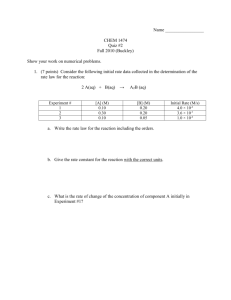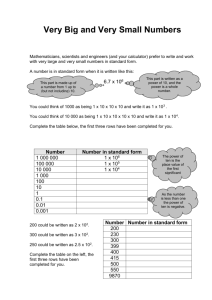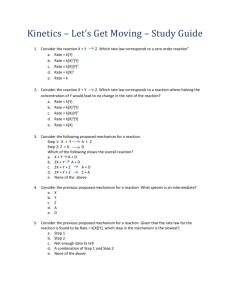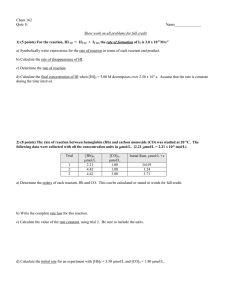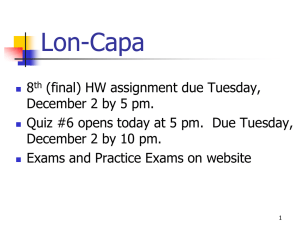Name _______________________ CHEM 1474 Test #2
advertisement
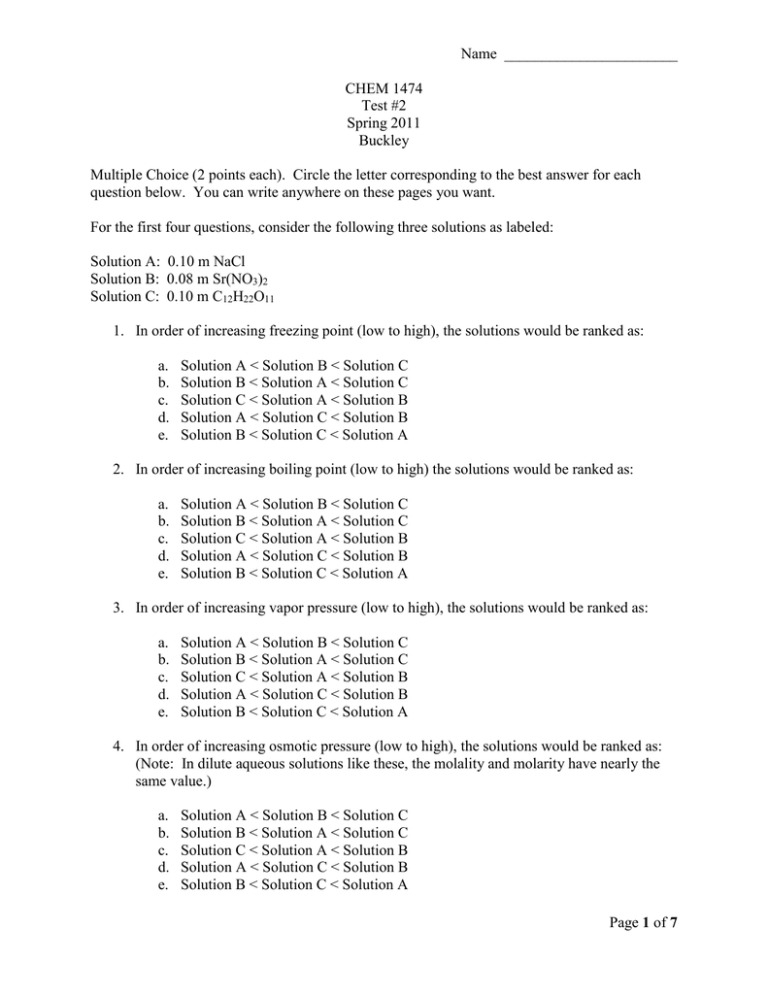
Name _______________________ CHEM 1474 Test #2 Spring 2011 Buckley Multiple Choice (2 points each). Circle the letter corresponding to the best answer for each question below. You can write anywhere on these pages you want. For the first four questions, consider the following three solutions as labeled: Solution A: 0.10 m NaCl Solution B: 0.08 m Sr(NO3)2 Solution C: 0.10 m C12H22O11 1. In order of increasing freezing point (low to high), the solutions would be ranked as: a. b. c. d. e. Solution A < Solution B < Solution C Solution B < Solution A < Solution C Solution C < Solution A < Solution B Solution A < Solution C < Solution B Solution B < Solution C < Solution A 2. In order of increasing boiling point (low to high) the solutions would be ranked as: a. b. c. d. e. Solution A < Solution B < Solution C Solution B < Solution A < Solution C Solution C < Solution A < Solution B Solution A < Solution C < Solution B Solution B < Solution C < Solution A 3. In order of increasing vapor pressure (low to high), the solutions would be ranked as: a. b. c. d. e. Solution A < Solution B < Solution C Solution B < Solution A < Solution C Solution C < Solution A < Solution B Solution A < Solution C < Solution B Solution B < Solution C < Solution A 4. In order of increasing osmotic pressure (low to high), the solutions would be ranked as: (Note: In dilute aqueous solutions like these, the molality and molarity have nearly the same value.) a. b. c. d. e. Solution A < Solution B < Solution C Solution B < Solution A < Solution C Solution C < Solution A < Solution B Solution A < Solution C < Solution B Solution B < Solution C < Solution A Page 1 of 7 5. The vapor pressure of pure water at 25 °C is 23.8 torr. What is the vapor pressure in torr of water above a solution prepared by dissolving 18.0 g of glucose (a nonelectrolyte, molar mass = 180.0 g/mol) in 95.0 g of water? a. b. c. d. e. 24.3 23.4 0.451 0.443 23.8 6. Pressure has an appreciable effect on the solubility of _________ in liquids. a. b. c. d. e. gases solids liquids salts solids and liquids . 7. Which of the following statements is false? a. Nonpolar liquids tend to be insoluble in polar liquids b. The weaker the attraction between the solute and solvent molecules, the greater the solubility. c. Substances with similar intermolecular attractive forces tend to be soluble in one another d. The solubility of a gas increases in direct proportion to its partial pressure above the solution. e. The solubility of gases in water decreases with increasing temperature. 8. Which produces the greatest number of ions when one mole is dissolved in water? a. b. c. d. e. NaCl NH4NO3 NH4Cl Na2SO4 sucrose 9. Consider the following reaction: 3A→ B Which of the following statements is true? a. b. c. d. the rate of disappearance of A equals the rate of appearance of B the rate of disappearance of A is three times the rate of appearance of B the rate of disappearance of A is one-third the rate of appearance of B the relationship between the rate of disappearance of A and the rate of appearance of B depends on the rate law e. there is insufficient information to draw any conclusions regarding the rate of appearance of A compared to the rate of disappearance of B Page 2 of 7 10. A flask is charged with 0.124 mol of A and allowed to react to form B according to the equation A(g) → B(g). The following data are obtained for [A] as the reaction proceeds.: Time (s): Moles of A: 0.00 0.124 10.0 0.110 20.0 0.088 30.0 0.073 40.0 0.054 The average rate of disappearance of A between 10 s and 20 s is: a. 2.2 × 10-3 mol/s b. 1.1 × 10-3 mol/s c. 4.4 × 10-3 mol/s d. 9.9 × 10-3 mol/s e. 454 mol/s 11. A reaction was found to be second order in carbon monoxide concentration. The rate of the reaction _____________ if the [CO] is doubled, with everything else being kept the same. a. b. c. d. e. doubles remains unchanged triples increases by a factor of 4 is reduced by a factor of 2 12. For a first-order reaction, a plot of _______ versus __________ is linear. a. ln[ A]t , 1 t b. ln[A]t, t c. 1 ,t [ A]t d. [A]t, t e. [A]t2, t 13. The initial concentration of reactant in a first-order reaction is 0.27 M. The rate constant for the reaction is 0.75 s-1. What is the concentration of reactant after 1.5 s? a. b. c. d. e. 3.8 M 1.7 M 8.8 × 10-2 M 2.0 × 10-2 M 0.135 M Page 3 of 7 14. Which one of the following graphs shows the correct relationship between concentration and time for a reaction that is second order in [A]? a. b. c. d. e. 15. Which of the following statements is true regarding the half-life of a second order reaction? a. b. c. d. e. the half-life is independent of the initial concentration if the initial concentration is doubled, the half-life becomes twice as long if the initial concentration is doubled, the half-life becomes one-half as long if the initial concentration is doubled, the half-life becomes four times longer if the initial concentration is doubled, the half-life becomes one-fourth as long 16. The rate constant for a second-order reaction is 2.75 × 10-2 M-1s-1. How much reactant would be left after 300 s if the starting concentration is 0.150 M? a. b. c. d. e. 3.92 × 10-5 M 14.9 M 0.147 M 6.70 × 10-2 M 0.131 M Page 4 of 7 Problems and Short Answers. Show your work on numerical problems to receive full credit. The point total for each problem is indicated in parentheses to the right of the problem number. 17. (10 points) 2.50-g of an unknown nonelectrolyte are dissolved in 55.0-g of CCl4. The resulting solution has a freezing point of -67.8 °C. The normal freezing point of CCl4 is -63.5 °C and its kf is 4.68 °C/m. Find the molar mass of the unknown. Show your work. 18. (10 points) Consider the following initial rate data. Experiment # 1 2 3 [A] (/M) 0.20 0.20 0.05 [B] (/M) 0.10 0.05 0.10 Rate (/(Ms-1) 5.0 × 10-2 2.5 × 10-2 1.25× 10-2 Write the rate law for the reaction including the orders and the value of the rate constant with appropriate units. Page 5 of 7 Potentially Useful Information R = 0.08206 L·atm/mol·K= 8.314 J/mol·K ln [ A]t kt [ A]o 1 1 kt [ A]t [ A]o ln k1 Ea 1 1 k2 R T2 T1 Page 6 of 7 Page 7 of 7
